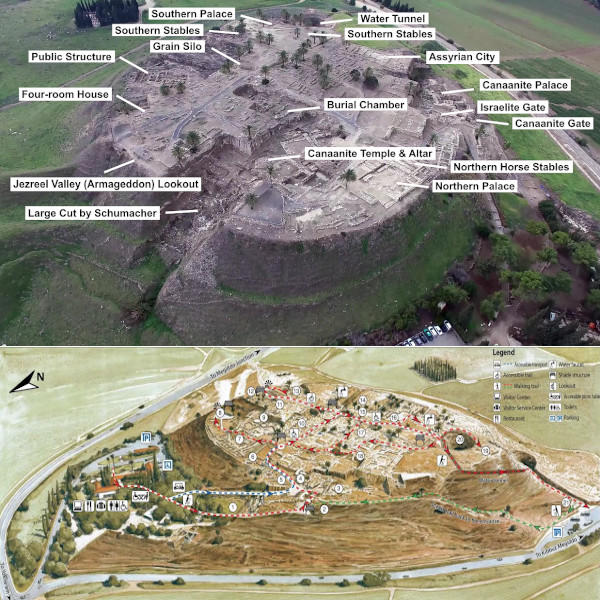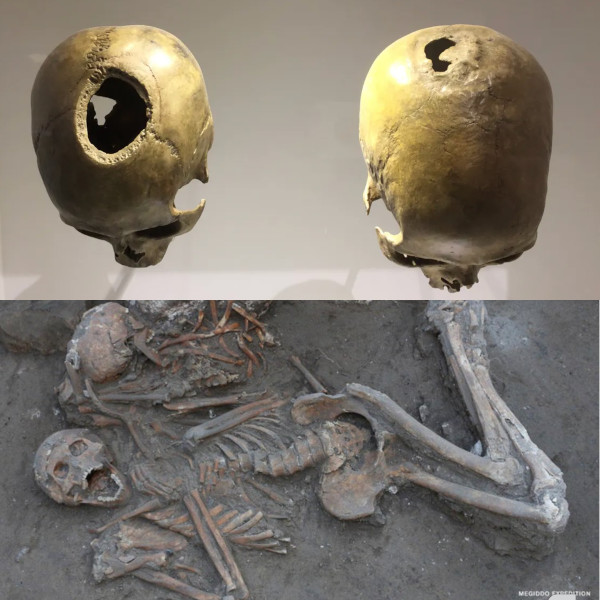DNA spotlight
Megiddo City of Armageddon
The Ancient city of Megiddo, also known today as Tel Megiddo in modern Israel, was first known in the Akkadian language used in Assyria as Magiddu. Described in the Book of Revelation as the site of the apocalyptic battle of Armageddon (Revelation 16:16), Megiddo was one of the strongest and most important Canaanite cities. Today experts know the ancient Canaanites were divided into independent city states, such as Megiddo, Hazor, and Acre. Most of the texts about them come from outsiders or later sources. The Canaanite people were also the forebearers of later peoples of the Levant region. Megiddo was an important Canaanite city state during the Bronze Age, approximately 3500 BC to 1200 BC DNA analysis reveals that the city population included migrants from the distant Caucasus Mountains. The ruins today include the remains of palaces, temples, gates and sophisticated water system with origins going back as far as 7000 BC. Megiddo was important in the ancient world - it guarded the western branch of a narrow pass on the most important trade route of the ancient Fertile Crescent, linking Egypt with Mesopotamia and Asia Minor (Anatolia) and known today as Via Maris.

By the mid 16th century BC, the Hittites, Mitanni and Babylonians had begun threatening Egypt. International trade was threatened and Canaan was unfortunately located in the crosshairs. Egyptian armies clashed with these ever-powerful neighbors in the Near East and Canaan was the crossroads between. In 1457 a coalition of Canaanite states led by the King of Kadesh rebelled against their Egyptian overlords and this culminated in the Battle of Megiddo - the oldest recorded Battle in History! The King of Kadesh assembled a vast coalition of Canaanites, Anatolians and Mesopotamians - an army of 15000 infantry, chariots and archers to fend of the Egyptians. Thutmose III was technically the ruler of Egypt in 1479 BC but his stepmother - the famous Hatshepsut - also his aunt - was his regent and effectively in power. In 1458 BC, when she died, Thutmose III became sole ruler and sent his armies to fight the Canaanites. The fortress city of Megiddo became the target, as it controlled the access between Egypt and Mesopotamia. Thutmose dispatched an army of 200000 men in the spring of 1457 BC and marched them towards Canaan.

On the great temple of Amon at Karnak in Egypt - shown here - the events of the battle of Megiddo were described in great detail - and serving as the first such record in history. Despite warnings of an ambush Thutmose insisted on the direct narrow pass to Megiddo, which spread his army into a 20 kilometres long column - a risky move indeed. He took the King of Kadesh by surprise and setup camp outside Megiddo. The Canaanites defenders fled as they discovered the Pharaoh himself was leading the charge. However Thutmose made a critical mistake by pillaging the countryside allowing the Canaanites to flee into the city walls - a long siege ensued. Months later and out of food, the citizens of Megiddo surrendered. Not long after the remaining Canaanite cities fell and the region fell under Egyptian rule. The spoils obtained included chariots made of gold, 892 regular chariots, Bronze armor, 502 bows, 2000 horses and 20,000 cattle. The citizens were spared but rather than kill the princes, they were captured and sent to Egypt to assimilate and adopt Egyptian culture. Later they would return to the region and promote the Egyptian agenda. The victory at Megiddo was quite important - it not only crushed the Canaanite rebellion but added much of the Levant as Egyptian territory and marked the resurgence of Egyptian military strength which lasted until the end of the Bronze Age.

Many DNA samples have been recovered from the site - among the most interesting are those of two brothers found in elite graves near the grand palace. The individuals were adorned with gold, silver and bronze jewellery and dozens of ceramic vessels with food offerings and bone inlays were found inside the tomb. Both showed signs of disease, one had a misshapen nose, and both showed signs of surgery on their skulls. One brother had survived the surgery and the other not - but they clearly had access to advanced medicine given their social status. Megiddo was later conquered by the Egyptians, rebuilt by the Israelites under King Solomon, once again placed under Egyptian rule, and finally became part of the Assyrian Empire before being abandoned. The name Megiddo appears 12 times in the Bible. The city of Megiddo was under the tribe Menashe and is mentioned in the context of the tribes failure to inherit the city. In the days of King Solomon, the city became the governors center. Additionally, it is mentioned in the construction activities that Solomon carried out in the town. Assyrian and Aramaic sources also mention Megiddo. The city certainly has a turbulent past - being conquered no less than 25 times according to archaeological evidence. Today it can be visited and explored and perhaps you too have ancestral ties to the city of Armageddon (Har-Megiddo - the mountain of Megiddo).
Sample: Elite Grave I Late Bronze Age Canaanite Megiddo
- Sample ID: I10769
- Year: 1500 BC
- Sex: Male
- Location: 32.58086,35.17648
Sample: Elite Grave II Late Bronze Age Canaanite Megiddo
- Sample ID: I10770
- Year: 1500 BC
- Sex: Male
- Location: 32.58086,35.17648
Sample: Late Bronze Age Canaanite Megiddo
- Sample ID: I10096
- Year: 1550 BC
- Sex: Male
- Location: 32.58086,35.17648
Sample: Late Bronze Age Canaanite Megiddo
- Sample ID: I10097
- Year: 1550 BC
- Sex: Female
- Location: 32.58086,35.17648
Sample: Late Bronze Age Canaanite Megiddo
- Sample ID: I10768
- Year: 1550 BC
- Sex: Male
- Location: 32.58086,35.17648
Sample: Late Bronze Age Canaanite Megiddo
- Sample ID: I4518
- Year: 1425 BC
- Sex: Male
- Location: 32.58086,35.17648
Sample: Late Bronze Age Canaanite Megiddo
- Sample ID: I4525
- Year: 1550 BC
- Sex: Male
- Location: 32.58086,35.17648
Sample: Late Bronze Age Canaanite Megiddo
- Sample ID: I2195
- Year: 1440 BC
- Sex: Male
- Location: 32.58086,35.17648
Sample: Megiddo Late Bronze Age
- Sample ID: I2198
- Year: 1470 BC
- Sex: Male
- Location: 33.9018,35.5012
Sample: Early Israelite Megiddo
- Sample ID: I4517
- Year: 1020 BC
- Sex: Male
- Location: 32.58086,35.17648
Sample: Late Bronze Age Canaanite Megiddo
- Sample ID: I8187
- Year: 1725 BC
- Sex: Male
- Location: 32.58086,35.17648
Sample: Late Bronze Age Canaanite Megiddo
- Sample ID: I8188
- Year: 1725 BC
- Sex: Male
- Location: 32.58086,35.17648
Sample: Late Bronze Age Canaanite Megiddo
- Sample ID: I10359
- Year: 1570 BC
- Sex: Male
- Location: 32.58086,35.17648
Sample: Late Bronze Age Canaanite Megiddo
- Sample ID: I10101
- Year: 1570 BC
- Sex: Male
- Location: 32.58086,35.17648
Sample: Late Bronze Age Canaanite Megiddo
- Sample ID: I10270
- Year: 1570 BC
- Sex: Female
- Location: 32.58086,35.17648
Sample: Late Bronze Age Canaanite Megiddo
- Sample ID: I10361
- Year: 1570 BC
- Sex: Male
- Location: 32.58086,35.17648
Sample: Late Bronze Age Outlier Canaanite Megiddo
- Sample ID: I2189
- Year: 1570 BC
- Sex: Male
- Location: 32.58086,35.17648
Sample: Late Bronze Age Outlier Canaanite Megiddo
- Sample ID: I2200
- Year: 1570 BC
- Sex: Female
- Location: 32.58086,35.17648
